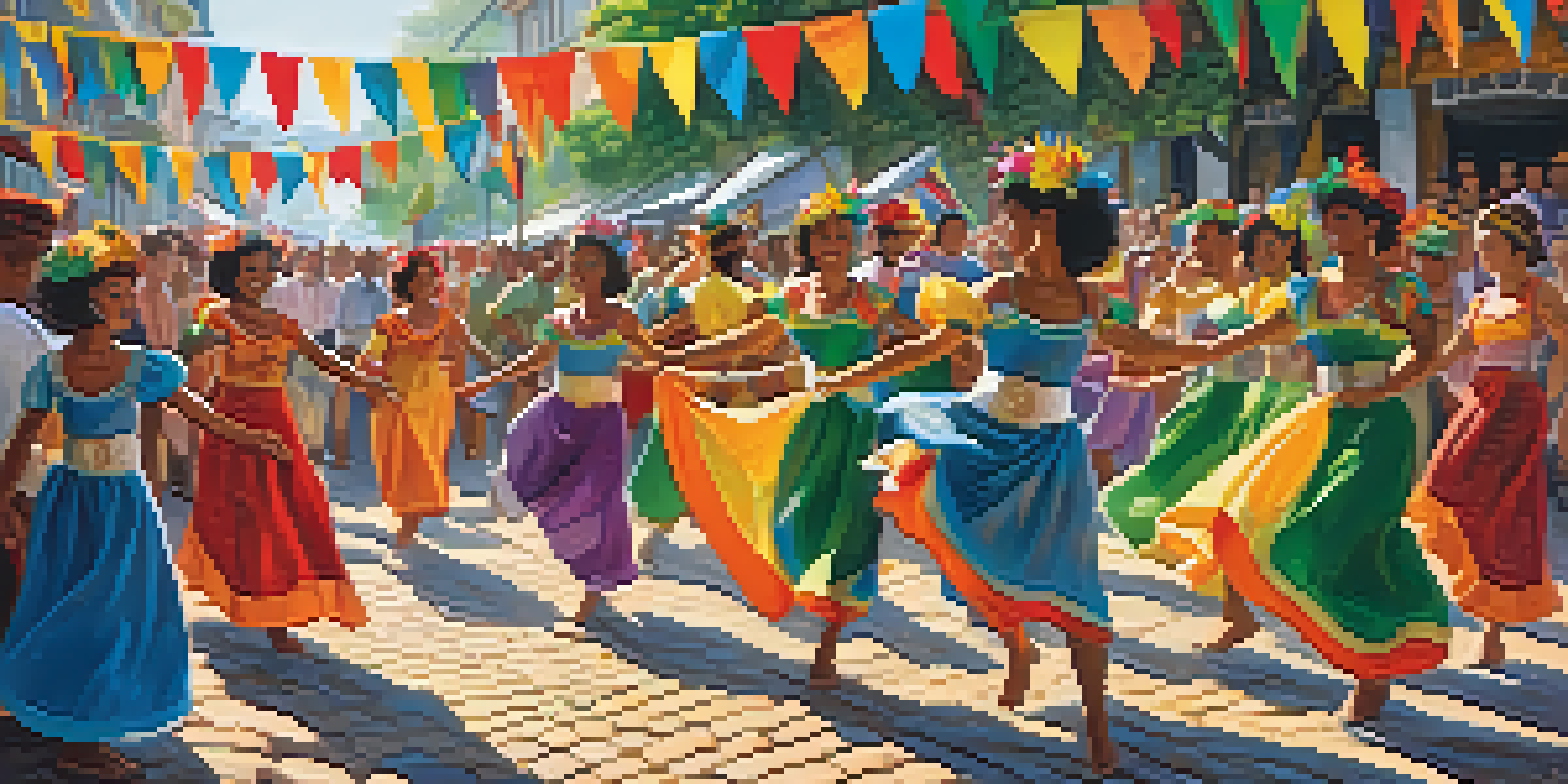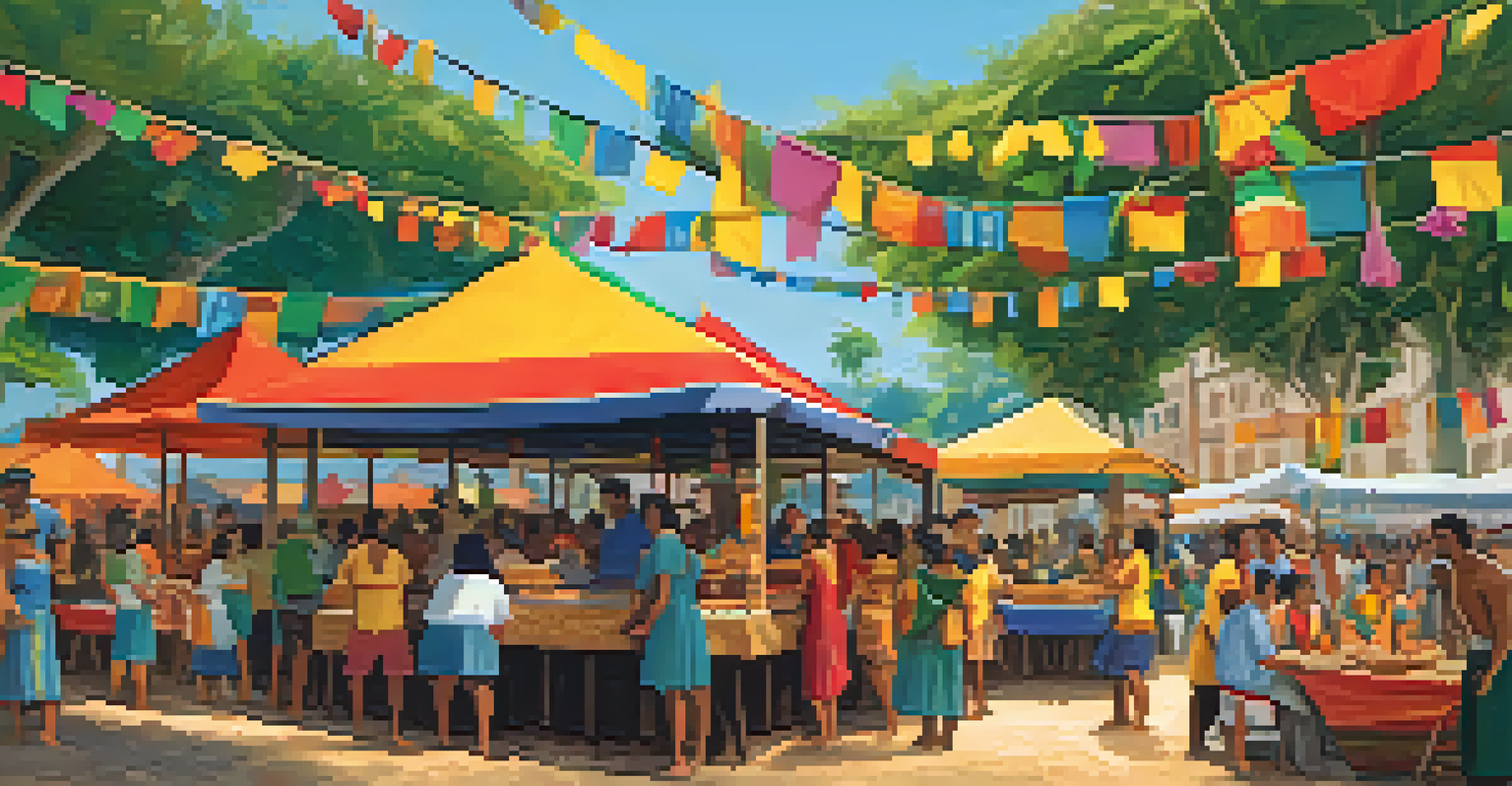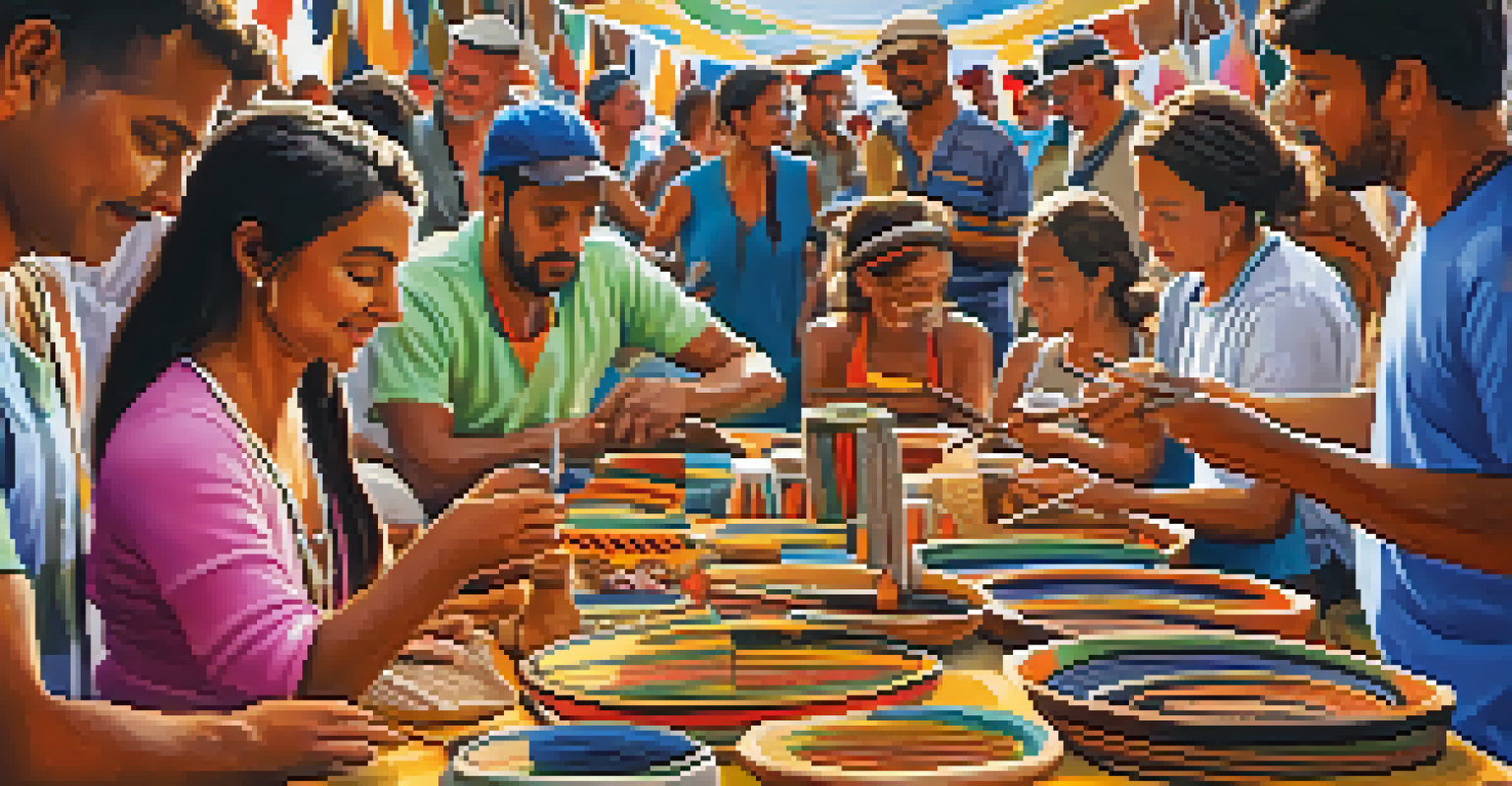Folk Festivals in Brazil: Celebrating Diversity and Heritage

The Heartbeat of Brazil: What Are Folk Festivals?
Folk festivals in Brazil are vibrant celebrations that showcase the country's rich cultural tapestry. These events are often rooted in local traditions, embodying the spirit and history of their communities. From music and dance to food and crafts, each festival offers a unique glimpse into Brazil's diverse heritage.
Folk festivals are the heartbeat of a community, celebrating its unique rhythms and stories.
Imagine a colorful carnival where the sounds of samba, forró, and other traditional music fill the air, inviting everyone to join in the revelry. Folk festivals are not just about entertainment; they are a way for communities to unite, pass down traditions, and celebrate their identities. This makes them an essential part of Brazil's social fabric.
Whether it's the lively streets of Olinda or the vibrant squares of Salvador, these festivals create a sense of belonging. They remind us that amidst Brazil's vastness, there is a shared love for culture and community that transcends geographical boundaries.
The Role of Music in Brazilian Folk Festivals
Music is the lifeblood of Brazilian folk festivals, setting the tone for celebration and connection. Each festival incorporates local rhythms that tell stories and convey emotions unique to the community. The infectious beats of samba or the soulful strumming of a berimbau during capoeira performances draw people in, inviting them to dance and celebrate together.

For example, the Festival de Parintins in Amazonas features a spectacular display of music and dance as participants reenact the legendary battle between the tribes of the Amazon. This event highlights not only the entertainment aspect of music but also its role in preserving local myths and traditions. It's a powerful reminder of how music can bridge generations.
Vibrant Cultural Celebrations
Folk festivals in Brazil showcase the country's rich cultural heritage through music, dance, food, and crafts.
Moreover, music at these festivals often serves as a medium for social commentary, reflecting the hopes and struggles of the people. So, when you hear that lively tune at a festival, know that it’s not just a song; it’s a story, a celebration, and a call for unity.
Dance: The Language of Celebration in Brazil
Dance is another integral element of Brazilian folk festivals, transforming the streets into vibrant stages of expression. Each dance style tells its own story, from the energetic movements of samba to the graceful steps of frevo. These dances are not just performances; they invite participation from everyone, regardless of age or skill level.
Music is the universal language of mankind, and it serves to unify us in celebration and culture.
Take the Festa Junina, for instance, where the quadrilha dance brings communities together in a joyful display of tradition. Dancers often dress in colorful outfits, evoking the rural roots of the festival while showcasing their unique flair. This connection to tradition fosters a sense of pride and belonging among participants.
As the rhythms pulse and the dancers move, there's a palpable sense of joy that envelops the crowd. This communal experience highlights one of the most beautiful aspects of Brazilian culture: the ability to come together through movement, celebrating life and heritage with every step.
Culinary Delights: Food at Brazilian Folk Festivals
Food is a cornerstone of Brazilian folk festivals, offering a delicious way to celebrate culture and heritage. Each festival features traditional dishes that reflect the local cuisine, from hearty stews to sweet desserts. This culinary diversity is a testament to Brazil's rich agricultural landscape and multicultural influences.
For example, during the Festa de Iemanjá in Bahia, you’ll find stalls brimming with fresh seafood, a nod to the goddess of the sea, while the Festa Junina features typical dishes like pamonha and canjica. These foods are not just sustenance; they carry stories and traditions that have been passed down through generations.
Music and Dance as Unifiers
Music and dance are central to Brazilian folk festivals, fostering community connection and preserving local traditions.
Moreover, sharing food at these festivals fosters a sense of community and warmth. Whether it’s sampling a plate of acarajé or enjoying a sweet treat, the culinary experience becomes a bonding moment for friends and families, reinforcing the idea that food, much like music and dance, is a universal language of celebration.
The Significance of Art and Craft in Folk Festivals
Art and craft play a vital role in Brazilian folk festivals, showcasing the creativity and talent of local artisans. From intricate handmade decorations to vibrant textiles, these artistic expressions reflect the cultural identity of the community. They serve as reminders of the skills that have been honed over generations and the stories behind them.
At festivals like the Feira de São Cristóvão, artisans display their crafts, offering visitors a chance to appreciate the beauty of traditional techniques. Whether it’s pottery, weaving, or painting, each piece tells a story of the community’s heritage and values. This connection to art enriches the festival experience, allowing attendees to take home a piece of the culture.
Moreover, engaging with these crafts offers a deeper understanding of Brazilian culture. It’s not just about buying souvenirs; it’s about recognizing the artistry and effort that go into creating these unique items. In this way, folk festivals become platforms for preserving and promoting local craftsmanship.
Embracing Diversity: Regional Variations of Festivals
Brazil is a vast country, and its folk festivals reflect the incredible diversity found within its borders. Each region has its own unique festivals that celebrate local traditions, languages, and customs. For instance, the Festa do Divino in Goiás showcases indigenous and Afro-Brazilian influences, while the Folia de Reis in Minas Gerais pays homage to the Three Kings with music and dance.
These regional variations highlight how different cultures coexist and enrich the Brazilian identity. Attending a festival in the North might immerse you in indigenous traditions, while a festival in the South could expose you to European influences. This melting pot of cultures is what makes Brazilian folk festivals so fascinating and unique.
Preserving Traditions for the Future
The future of Brazilian folk festivals depends on innovative approaches to engage younger generations while maintaining authenticity.
By celebrating these regional differences, folk festivals promote understanding and appreciation among diverse communities. They remind us that while we may come from different backgrounds, we all share the same desire to celebrate life, love, and heritage together.
The Future of Folk Festivals in Brazil
As we look to the future, the preservation of folk festivals in Brazil faces both challenges and opportunities. Globalization and urbanization can sometimes overshadow local traditions, making it essential to adapt while maintaining authenticity. However, there is a growing movement to ensure that these festivals remain relevant and accessible to younger generations.
Innovative approaches, such as incorporating modern technology and social media, are helping to promote folk festivals and engage new audiences. For instance, live-streaming events or creating interactive platforms allows people from all over the world to experience these vibrant celebrations without being physically present. This fusion of tradition and technology can breathe new life into age-old customs.

Ultimately, the future of Brazilian folk festivals lies in the hands of the communities that cherish them. By fostering a sense of pride and encouraging participation, these festivals can continue to thrive, ensuring that the rich tapestry of Brazilian culture remains vibrant for generations to come.